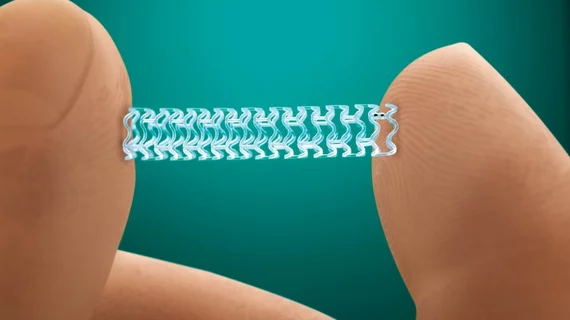The bioresorbable vascular scaffold (BVS), once an exciting prospect for cardiologists, saw a unique rise and fall in popularity within a year of its introduction to the CV market. A JAMA Cardiology analysis found physicians reacted “appropriately” to the phenomenon, absorbing new data as it was published and using the method selectively in patients.
BVS—an alternative to the traditional bare-metal stent—was first introduced to the U.S. market by Abbott Vascular in 2016. Abbott’s Absorb BVS was designed to fully dissolve within a patient’s vessels two to three years after its implantation via percutaneous coronary intervention (PCI), bypassing any negative side effects that might have been sustained by a metal stent. Positive results from initial trials pushed the BVS through FDA approval, but by the time Abbott announced the longer-term results of the ABSORB III trial at TCT 2017, the picture was looking different.
Although ABSORB investigators found the Absorb BVS was noninferior to another Abbott stent, the everolimus-eluting Xience stent, at one year, results at three years suggested Xience was more effective. The device-oriented primary endpoint of target lesion failure occurred in 13.4% of BVS patients compared to 10.4% of Xience patients, and those with BVS also saw higher rates of target vessel failure, death, MI and revascularization.
In JAMA, first author Katherine Hsin-Yu Chau, MD, and colleagues also made note of the AIDA trial, which linked BVS to a higher incidence of device thrombosis than drug-eluting stents at two years. After months of unfavorable press, Abbott pulled both its BVS models from the global market in an 82-word statement posted Sept. 8, 2017.
Chau, of Columbia University Medical Center and New York Presbyterian Hospital, and co-authors conducted an analysis of more than 682,000 stent procedures between January 2016 and June 2017 to get an idea of how physicians responded to the yearlong influx of reports—both good and bad—about BVS.
“The medical device approval process has been increasingly criticized and physicians have often been depicted as too enthusiastic in their embrace of technologies without adequate data to inform practices,” Chau et al. wrote. “Bioresorbable vascular scaffolds are one such device for which this criticism has been levied.”
The team pulled data from the NCDR CathPCI Registry, which represents 85% of cardiac catheterization labs in the U.S. and logs all PCI procedures with the implant of either BVS or a conventional stent. Of the 682,951 procedures they identified, just 0.6% used BVS.
Chau and colleagues reported BVS implantation occurred most frequently in patients with fewer comorbidities and lower-acuity presentations—characteristics not dissimilar to inclusion criteria for the ABSORB studies. The maximum monthly use of BVS reached 1.25% of all PCI procedures that took place within 90 days of the device’s FDA approval, but there was significant site-to-site variability, with urban and teaching hospitals more likely to use the new approach.
Overall use was relatively low across the board, though. Eighty percent of hospitals didn’t report any BVS use, and after adverse data were published and the FDA issued a safety alert for the device, physicians’ use of BVS declined in kind.
“It should be noted that even before the release of the ABSORB II long-term outcome data, meta-analyses and initial postmarket studies had already raised potential safety concerns regarding BVS use,” Chau et al. said. “This may explain the relatively slow initial uptake for the device as well as the rapid temporal declines in use following the additional release of longer-term clinical trial data by physicians who were ‘primed’ for potentially negative results from these antecedent data as well as lessons following the initial release of DES.”
The team said their results could have been affected by the fact that not all hospitals had equal access to BVS, whether that be because of pricing concerns or difficulty with physicians implanting the new devices. Still, they wrote, the case represents an appropriate physician response to adverse data publication and FDA warnings.

